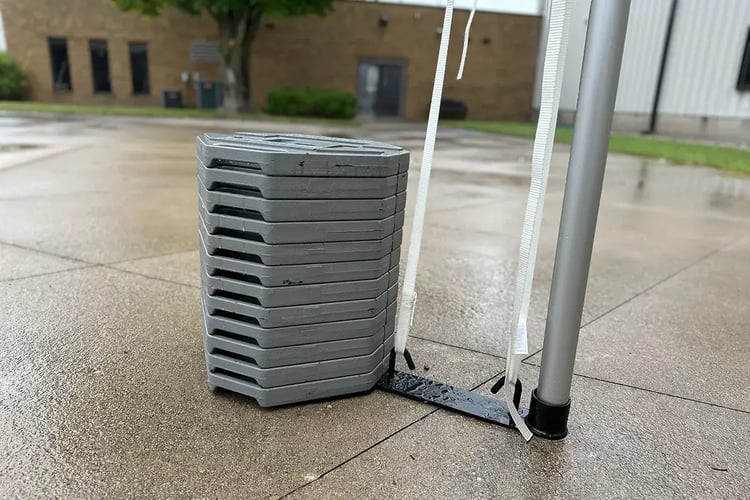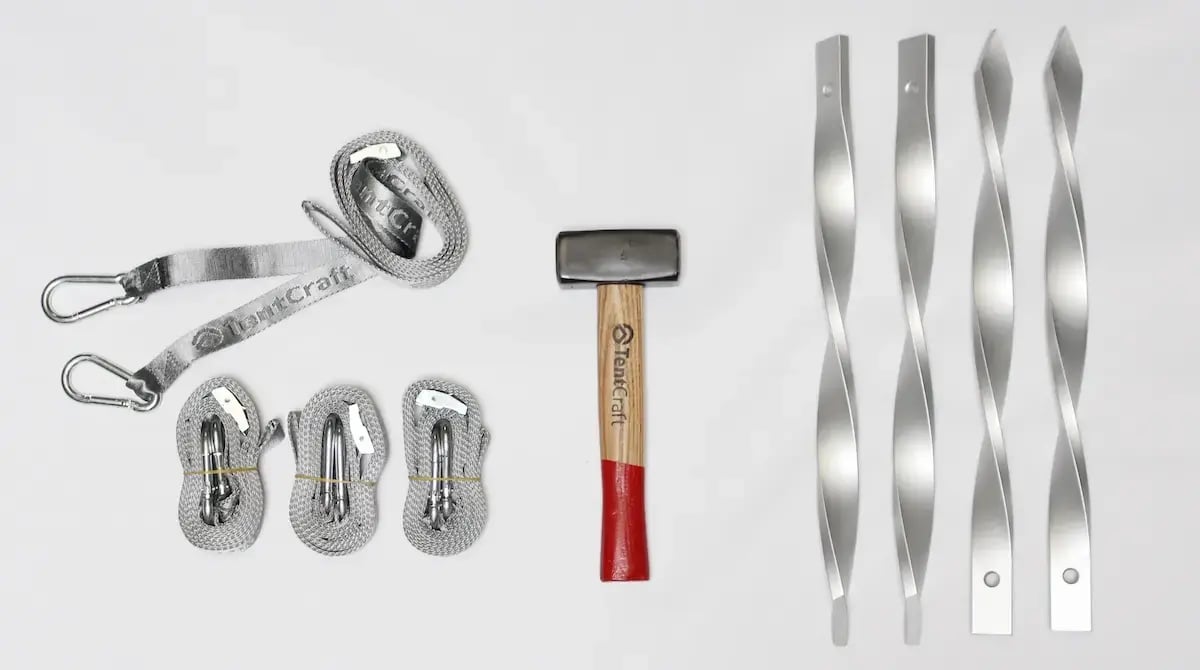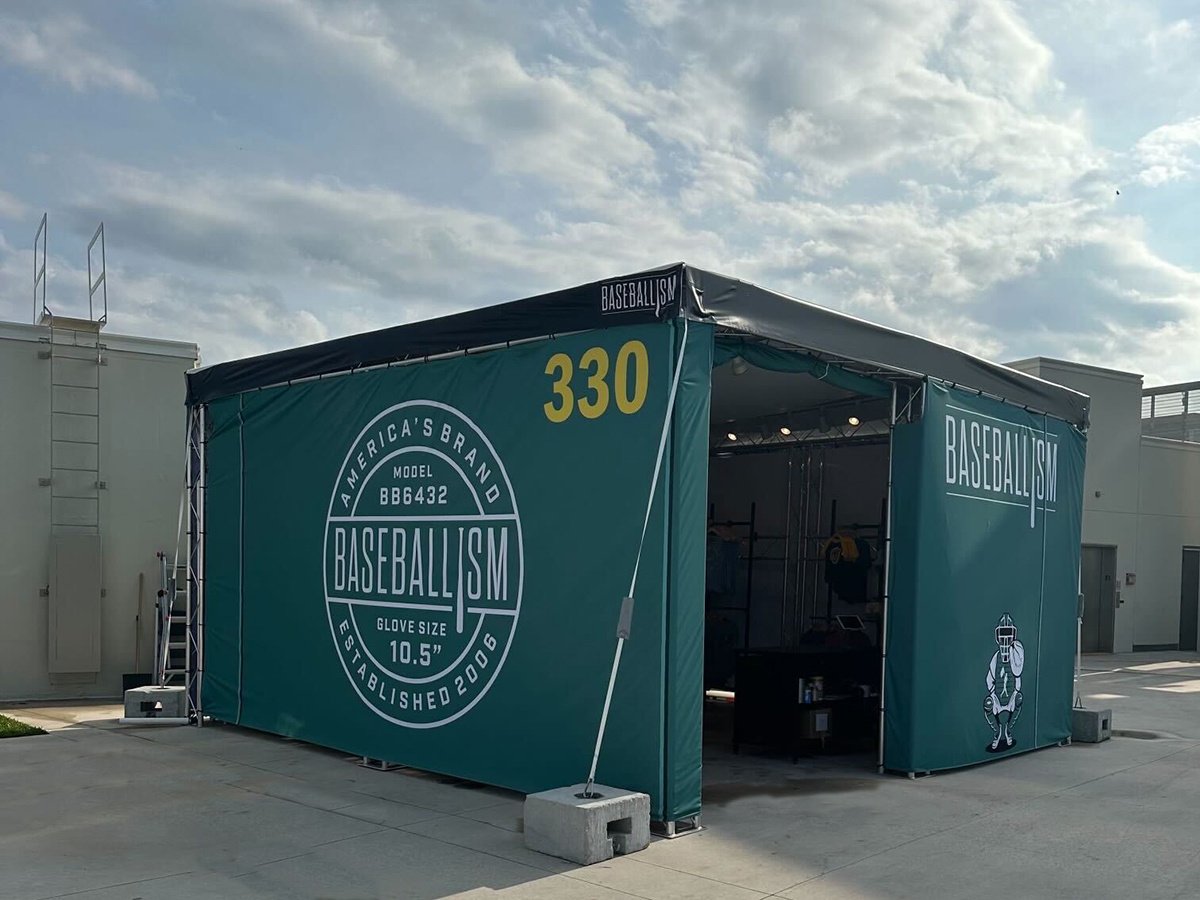
The 5 Best Ways to Anchor a Canopy for High Winds (Whether on Sand and Soil or Concrete)
Your custom pop-up canopy looks a lot better on the ground than it does in a tree.
Kidding aside, figuring out the best way to anchor a canopy is one of the most common pop-up tent problems we get asked about. You want to protect your investment from becoming damaged or possibly damaging something (or someone!) nearby when there are heavy winds in the forecast.
As a U.S. canopy tent manufacturer of some of the most durable pop-up tents on the market, we know a thing or two about canopy anchors that we know you'll find helpful. Whether you’re setting up on the beach or wondering how to anchor a canopy on concrete, here are some of the best canopy anchor ideas to use at your next event.
How to Keep Your Canopy From Blowing Away (TL;DR)
You have plenty of options when it comes to ballasting a canopy tent. These are some of the most common ways to weigh down a 10x10 pop-up canopy and larger sizes:
- Tie down your canopy using tent stakes
- Secure sandbags to your canopy tent
- Water barrels - allow for more and less weight
- Strap down your canopy using concrete blocks
- Try weighted footplates specifically designed for canopy tents
1. Use Tent Stakes to Tie Down Your Canopy (Large, High-Quality Stakes Make a Huge Difference)
If you’re setting up on grass, loose gravel, or soil, you'll be able to use heavy-duty tent stakes, tie-down straps, and some well-tied slip knots. We like this method of anchoring so much that we actually include a stake kit, complete with guy straps, with all of our custom pop-up tent models. Connect the guy straps to each upper corner of the tent’s frame and anchor it to the stake at a 45-degree angle for maximum stability.
Pro Tip: Find stakes that are large enough and ideally designed with a twist that allow for ample sturdiness in soil. You'll notice that some tent companies provide tiny, thin stakes (if any at all) that aren't equipped to keep a canopy safely in place.
Example of TentCraft's Stake Kit:

2. Try Sandbags Strapped To Your Canopy Tent Frame
Sand is accessible, cheap, and, thankfully, heavy enough that, when evenly distributed across your tent’s frame, can efficiently anchor your setup.
Sandbags, like the ones we sell, can weigh about 35 lbs. each when filled with sand and a little bit of water. This is a great option when you’re set up on a beach because, well, sand is readily available!
Pro Tip: Sandbangs are also a great option if you're concerned about shipping costs, because with sandbags, you don't pay for the weight of the sand — just the softgoods.

3. Water Barrels Make Great Anchors For Larger Canopy Structures
When you’re dealing with larger canopy structures such as semi-permanent frame tents installed on concrete, you need a heavier anchoring solution, like water barrels.
The water barrels that TentCraft sells, when filled, weigh 660 lbs. That means a water barrel on each corner gives you more than 2,600 lbs. of anchoring support!
Water barrels can get a bad rap to the point where some tent sellers, including some of our competitors, won't even sell them out of fear they will tip over and make a huge mess and cause damage. TentCraft water barrels are different, though. Most water barrel anchors, like the ones you can purchase at Home Depot, require you to attach your tent only to the top of the barrel. Our patented design, though, calls for the straps to go all the way to the bottom of the barrel — through the water — through the metal loop that's positioned in the middle of the bottom of the barrel and back up again. This provides for a much more stable anchor.
Here’s how we recommend setting up water barrels on TentCraft tents.
Pro Tip: We've seen breweries fill empty kegs with water for this purpose as well.
4. Using Concrete To Weigh Down Your Canopy Tent or Wrapped Truss

Concrete cinder blocks are easy to find, but be careful as the average cinder block weighs only 28 lbs. Depending on the size of your tent, that might not be heavy enough.
A creative option is to take a 5-gallon bucket and fill it ⅔ full with concrete mix. While it’s still wet, set a large eye-bolt that can be used to attach your tent’s anchor.

Alternatively, concrete ballasting blocks work well with frame tents. Some hardware stores can make ballasting blocks with a hook in them to attach your tent to.
If you're looking for something that's more professional, in terms of concrete anchors, we recommend reaching out to Block and Roll Innovations, which makes excellent concrete tent anchors.
5. Use Footplates Designed Specifically for Canopy Tents
At TentCraft, we love footplates for our heavy-duty MONARCHTENT and medium-duty mightyTENT — especially for farmers market tents that need to be anchored on concrete parking lots.
We engineered and handcrafted 50 lbs. cast-iron footplates that perfectly attach to the legs of your tent. As you can see in this video, it’s pretty simple to install the footplates. And when you’re done using your tent for the day, you can easily store them.

Pro tip: We've also seen marketing teams and small business owners tie down their canopy tents using heavy kettlebells. The handle makes for a convenient place to attach the straps to the weight.
Considerations When Properly Anchoring (Ballasting) Canopy-Based Structures
Wind Speed
The strength of the wind impacts how much weight and which techniques are going to be most effective.
Large, lighterweight tents with more canopy square footage to grab onto, especially if you have additional walls will require more weight to help your tent stay securely on the ground. (See our weight guides below for more specifics).
How do you anchor a canopy to concrete or hard surfaces vs sand or soil?
When anchoring to concrete, you won't have the option to use stakes like you would with softer ground.
However, as listed above, there are still plenty of way to secure your canopy by using:
- Weighted footplates
- Water barrels
- Concrete blocks
- Concrete in 5-gallon buckets with a hook
- Kettlebells
- Sandbags
Weight of Tent and Soft Good Accessories
Larger canopy tents often weigh more than their smaller counterparts and so the additional amount of weight needed to anchor them is not directly proportional to how much bigger they are in square footage.
For example, 200 lbs. depending on the conditions is an acceptable anchor weight for both our 10'x10' canopy tents and our 10'x15' because, in part, the additional weight of the 10'x15' means it doesn't always need as much anchor weight. (See below guides for more details.)
As mentioned in the wind speed section, if you have additional soft good canopy products such as full or half-walls, you might need more weight to compensate for the fact that these can act as sails for the wind to grab ahold of.
How Much Weight Is Needed to Hold Down My Canopy Tent?
Our in-house team of engineers have helped us come up with recommended weights for the most-common pop-up canopy tents.
Read the specific articles here for more details:
Anchoring a TentCraft Canopy Pop-Up Tent
As an American manufacturer of pop-up tents, we live and breathe tents every day. So, do we have a favorite anchoring method? Not really, but we’d first recommend our footplates since they are:
- Easy to install
- Aesthetically pleasing thanks to their minimalist design.
While all TentCraft tents come with a certified wind rating from a professional engineering firm, that rating only means something when the tent is properly anchored. When winds start flirting with 30 mph to 40 mph gusts, you definitely need a secure anchor, or your tent is going to start moving.
Still have questions about anchoring your pop-up tent? Send us a note and let TentCraft help you today.